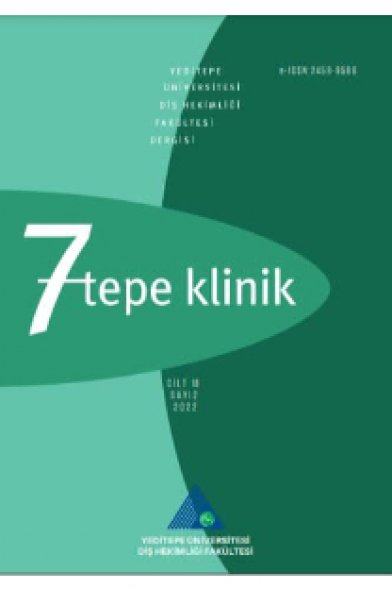A methodological study on improving a new orthodontic face mask
Yeni bir ortodontik yüz maskesi geliştirilmesi üzerine metodolojik bir çalışma
___
- M.P. Major, J.K. Wong, H. Saltaji, P.W. Major and C. Flores-Mir. Skeletal Anchored Maxillary Protraction for Midface Deficiency in Children and Early Adolescents with Class III Malocclusion: A systematic Review and Me- ta-Analysis. Journal of the World Federation of Orthodon- tists 2012; 1: e47-e54.
- P. Ngan and W. Moon. Evolution of Class III Treatment in Orthodontics. American Journal of Orthodontics and Dentofacial Orthopedics 2015; 148: 22-36.
- S. Pattanaik and S. Mishra. Treatment of Class III with Face mask Therapy. Case Reports in Dentistry 2016; Arti- cle ID 6390637, 1-8.
- H.J. De Clerck and W.R. Proffit. Growth Modification of the Face: A Current Perspective with Emphasis on Class III Treatment. American Journal of Orthodontics and Den- tofacial Orthopedics 2015; 148: 37-46.
- C.T. Hino, L.H. Cevidanes, T.T. Nguyen, H.J. De Cler- ck, L. Franchi and J.A. McNamara Jr. Three-Dimensional Analysis of Maxillary Changes associated with Face mask and Rapid Maxillary Expansion Compared with Bone An- chored Maxillary Protraction. American Journal of Ortho- dontics and Dentofacial Orthopedics 2013; 144: 705-714.
- D. Gencer, E. Kaygisiz, S. Yüksel and T. Tortop. Compar- ison of Double-Plate Appliance/Face mask Combination and Face mask Therapy in Treating Class III Malocclu- sions. The Angle Orthodontist 2014; 85: 278-283.
- P.V.P. Oltramari-Navarro, R.R.D. Almeida, A.C.D.C.F. Conti, R.D.L. Navarro, M.R.D. Almeida and L.S.A.F.P. Fer- nandes. Early Treatment Protocol for Skeletal Class III Malocclusion" Brazilian Dental Journal 2013; 24: 167
- D.X. Gu, C.Y. Liang, X.G. Li, S.L. Yang and P. Zhang. In- telligent Technique for Knowledge Reuse of Dental Med- ical Records Based on Case-Based Reasoning. Journal of Medical Systems 2008; 34: 213-222.
- J.C. Palma, N. Tejedor-Sanz, M.D. Oteo and J.A. Alarcón. Long-term Stability of Rapid Maxillary Expansion Com- bined with Chincup Protraction Followed by Fixed Appli- ances. The Angle Orthodontist 2014; 85: 270-277.
- U.N. Soni, M.J. Baheti and N.G. Toshniwal. Orthodon- tic Headgear and Ocular Injuries. Journal of Advanced Medical and Dental Sciences Research 2014; 2: 1-7.
- P. Foltynski, B. Mrozikiewicz-Rakowska, P. Ladyzyns- ki, J.M. Wójcicki and W. Karnafel. The Influence of Ambi- ent Temperature on Foot Temperature in Patients with Diabetic Foot Ulceration. Biocybernetics and Biomedical Engineering 2014; 34: 178-183.
- H.R. Tranel, E.A. Schroder, J. England, W.S. Black, H. Bush, M.E. Hughes, K.A. Esser and J.L. Clasey. Physical Activity, and not Fat Mass is a Primary Predictor of Circa- dian Parameters in Young Men. Chronobiology Interna- tional 2015; 32: 832-841.
- F. Piotr, L. Piotr, B. Martin, G. Julius, M.M. Karolina, M. Maria, S. Stanislawa and C. Anna. Continuous Monitoring of Feet Temperature Using a Data Logger with Wireless Communication. Biocybernetics and Biomedical Engi- neering 2012; 32: 59-64.
- M.R. Boon, L.E. Bakker, R.A. van der Linden, L. Perei- ra Arias-Bouda, F. Smit, H.J. Verberne, W.D. van Marken Lichtenbelt, I.M. Jazet and P.C. Rensen. Supraclavicular Skin Temperature as a Measure of 18F-FDG Uptake by BAT in Human Subjects. PLoS One 2014; 9: 1-8.
- E.A. Gil and X.L. Aubert, Beersma DGM. Ambulatory Estimation of Human Circadian Phase using Models of Varying Complexity based on Non-Invasive Signal Mo- dalities. 36th Annual International Conference of the IEEE Engineering in Medicine and Biology Society 2014; p2278-2281.
- L. Brabyn, P. Zawar-Reza, G. Stichbury, C. Cary, B. Sto- rey, D.C. Laughlin and M. Katurji. Accuracy Assessment of Land Surface Temperature Retrievals from Landsat 7 ETM + in the Dry Valleys of Antarctica using iButton Tem- perature Loggers and Weather Station Data. Environmen- tal Monitoring and Assessment 2013; 186: 2619-2628.
- B. McFarlin, A. Venable, R. Williams and A. Jackson. Comparison of Techniques for the Measurement of Skin Temperature during Exercise in a Hot, Humid Environ- ment. Biological Sport 2015: 32: 11-14.
- ISSN: 2458-9586
- Yayın Aralığı: 3
- Başlangıç: 2005
- Yayıncı: Yeditepe Üniversitesi Rektörlüğü
Endodontik-periodontal lezyonlu mandibular moların kombine tedavisi: Bir olgu sunumu
Fatma KANMAZ, Turan Emre KUZU, RECAİ ZAN, DEMET ALTUNBAŞ
Prosthetic restoration types of dental implants
Zeynep KAYAHAN ÖZKURT, Ender KAZAZOĞLU
Diş renkleşmeleri ve beyazlatma tedavileri
Zümrüt Ceren ÖZDUMAN, Çiğdem ÇELİK
Classification and current treatment options of endo-perio lesions
GİZEM İNCE KUKA, Güher BARUT, HARE GÜRSOY
Evaluation of different instrumentation systems for apical extrusion of debris
RECAİ ZAN, HÜSEYİN SİNAN TOPÇUOĞLU, İHSAN HUBBEZOĞLU, JALE TANALP, Meric KAZANDAĞ KARAPINAR
A methodological study on improving a new orthodontic face mask
NURHAT ÖZKALAYCI, MEHMET YETMEZ
Yaşar Meriç TUNCA, DURSUN ALİ ŞİRİN
Partial edentulism and treatment options
Zeynep KAYAHAN ÖZKURT, Ceyda TOMRUK ÖZÇAKIR, Ender KAZAZOĞLU
Multidisciplinary treatment for a young patient with severe bone loss from a trauma: A case report
